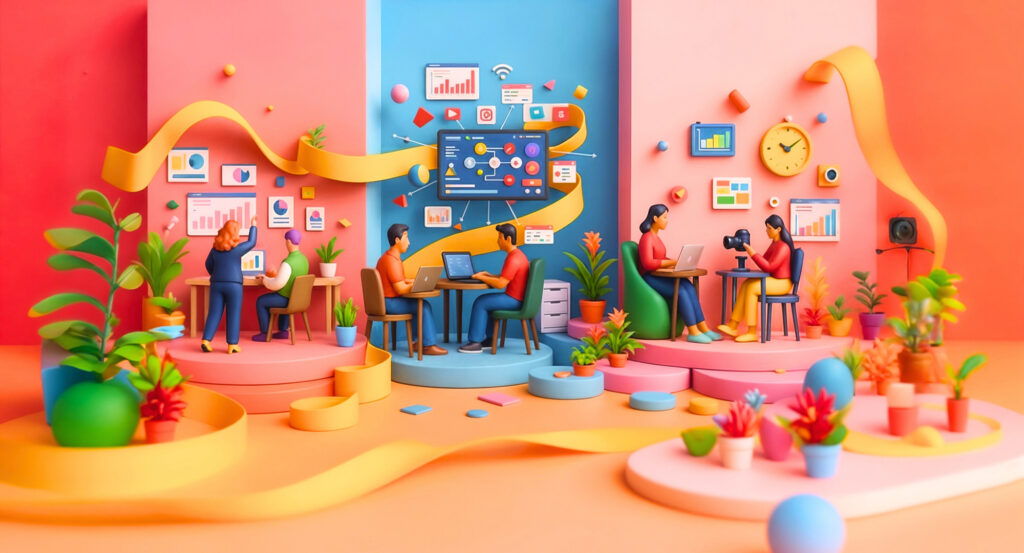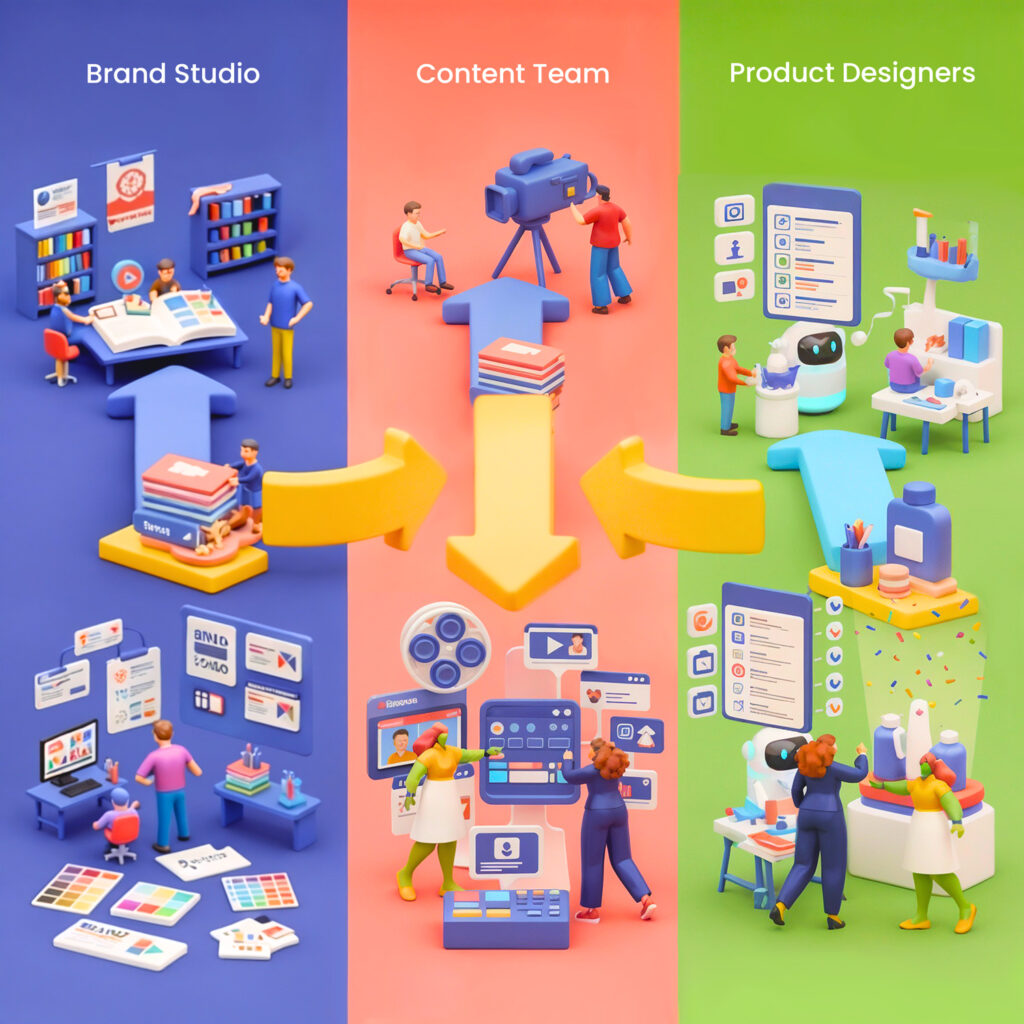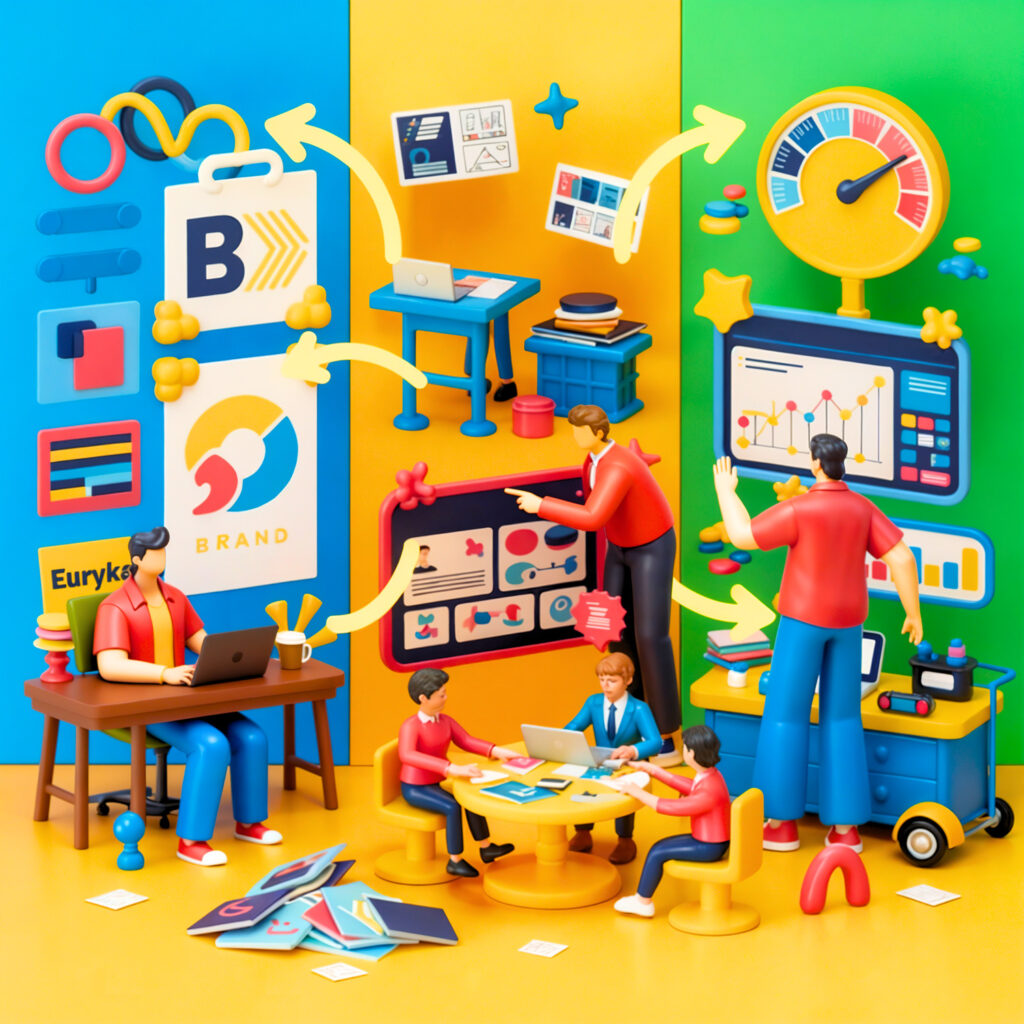Learn how different creative industry verticals require specialised AI orchestration approaches to maximise efficiency, quality, and competitive advantage.

When Marcus launched his digital marketing agency, he assumed that the AI orchestration system that worked brilliantly for his friend’s brand design studio would be perfect for his team. Both were creative businesses, both used similar AI tools, both needed systematic workflows to scale their operations.
Three months later, Marcus was struggling with an orchestration system that felt completely misaligned with his team’s actual work. The brand-focused workflows were irrelevant to his campaign-driven projects. The long-term brand development tools were useless for his rapid-iteration digital marketing cycles. The identity-focused quality controls missed the performance metrics that actually mattered for his clients.
The breakthrough came when Marcus realised that creative industries aren’t just different in scale or client type – they’re fundamentally different in how they create value, measure success, and deliver results. His digital marketing vertical required orchestration strategies that were completely different from brand design, even though both were “creative” work.
As Mei, our Systems Architect, often explains: “The most effective AI orchestration systems aren’t the most feature-complete – they’re the ones most precisely engineered for how specific creative verticals actually operate, what they’re trying to achieve, and how they measure success.”
Most AI orchestration implementations treat creative work as if it’s universally similar: teams need to create content, maintain brand consistency, and collaborate effectively. Whilst these needs exist across creative verticals, they manifest in completely different ways depending on the specific creative discipline and business model.
Brand design studios focus on long-term identity development and strategic visual thinking. Digital marketing agencies prioritise rapid campaign iteration and performance optimisation. Content creation teams emphasise volume production and multi-platform adaptation. Each vertical requires fundamentally different orchestration approaches.
When AI orchestration aligns precisely with creative vertical requirements, it creates competitive advantages that extend far beyond operational efficiency. Brand studios achieve identity consistency that builds lasting brand equity. Marketing agencies deliver campaign performance that drives measurable business results. Content teams produce volume and variety that captures audience attention across multiple channels.

Brand design studios operate with extended project timelines and strategic thinking horizons that differ fundamentally from other creative verticals. Projects often span months or years, involving comprehensive research, strategic positioning, and systematic identity development.
Effective brand studio orchestration optimises for consistency across extended timelines, systematic exploration of creative directions, and comprehensive documentation of brand systems. The orchestration system must support deep creative thinking whilst maintaining systematic approaches to identity development.
Brand studios create complex identity systems that include logos, typography, colour palettes, imagery styles, voice guidelines, and application standards. AI orchestration systems must manage these comprehensive brand systems whilst enabling creative exploration and systematic development.
Brand design work requires integration of market research, competitive analysis, audience insights, and strategic positioning. AI orchestration systems must incorporate this research systematically whilst enabling creative interpretation and strategic application.
Digital marketing agencies operate with fundamentally different success metrics than other creative verticals. Creative work is measured by performance data, conversion rates, engagement metrics, and business results rather than aesthetic excellence or brand consistency alone.
Effective marketing agency orchestration optimises for rapid iteration, performance testing, and data-driven creative optimisation. The system must enable quick creative development whilst incorporating performance feedback and systematic optimisation based on campaign results.
Digital marketing agencies create campaigns that span multiple channels, platforms, and formats simultaneously. AI orchestration systems must coordinate creative development across these diverse channels whilst maintaining campaign coherence and message consistency.
Marketing agencies must integrate real-time performance data into creative development processes, enabling rapid optimisation and systematic improvement based on campaign results. AI orchestration systems need to incorporate this performance feedback systematically whilst maintaining creative quality.

Content creation teams face unique orchestration challenges related to volume production, format diversity, and platform-specific optimisation. They must produce large quantities of content across multiple formats whilst maintaining quality standards and brand consistency.
Effective content team orchestration optimises for production efficiency, format adaptation, and systematic quality control across high-volume creative output. The system must enable rapid content creation whilst maintaining creative standards and platform-specific optimisation.
Content teams create materials that must work effectively across diverse platforms, each with unique technical requirements, audience expectations, and performance metrics. AI orchestration systems must systematically adapt content for platform-specific optimisation whilst maintaining creative coherence.
Content teams generate large volumes of creative assets that must be systematically organised, tagged, and made available for reuse across different projects and platforms. AI orchestration systems need to manage this asset complexity whilst enabling efficient creative development.
Whilst each creative vertical requires unique orchestration approaches, successful implementations address common creative challenges through vertical-appropriate solutions:
Quality Assurance: Brand studios focus on identity consistency, marketing agencies emphasise performance optimisation, content teams prioritise engagement metrics.
Creative Collaboration: Brand studios facilitate strategic client education, marketing agencies coordinate performance-driven iteration, content teams manage high-volume production workflows.
Asset Management: Brand studios organise comprehensive identity systems, marketing agencies manage campaign variations, content teams handle high-volume creative libraries.
Performance Measurement: Brand studios track brand equity development, marketing agencies monitor campaign performance, content teams measure audience engagement.
Creative verticals that develop specialised AI orchestration capabilities create sustainable competitive advantages that become increasingly difficult for competitors to replicate. These advantages compound over time as orchestration systems accumulate vertical-specific intelligence and optimisation.

Successful vertical-specific orchestration begins with comprehensive understanding of your creative discipline’s unique requirements, constraints, and success metrics. This includes industry standards, client expectations, competitive pressures, and vertical-specific creative challenges.
Teams need to map their creative vertical’s distinctive characteristics before designing orchestration strategies. What technical requirements exist? What performance metrics matter most? What competitive advantages are most valuable?
Vertical-specific orchestration requires AI systems trained on relevant creative work and optimised for vertical-appropriate outcomes. Brand studios need identity consistency, marketing agencies need performance optimisation, content teams need engagement maximisation.
Each creative vertical has unique workflow requirements that must be built into orchestration systems rather than adapted from generic templates. Brand studios need long-term development processes, marketing agencies need rapid iteration cycles, content teams need volume production workflows.
Different creative verticals require integration with different industry tools, platforms, and systems. Brand studios coordinate with brand management platforms, marketing agencies integrate with performance analytics tools, content teams connect with social media management systems.
As AI orchestration matures within creative industries, we’re seeing increasing specialisation within creative verticals. Brand studio orchestration is developing subspecialties for different identity types and strategic approaches. Marketing agency orchestration is specialising for different campaign types and performance objectives.
Creative verticals are evolving as the industry adapts to new technologies, market conditions, and client expectations. Hybrid vertical models are emerging, specialised firms are expanding into adjacent verticals, and new creative disciplines are developing unique orchestration requirements.
Whilst each creative vertical requires specialised approaches, successful orchestration strategies often adapt insights from other verticals. Brand studios learn from marketing agencies’ performance focus, marketing agencies adopt content teams’ volume production methods, content teams incorporate brand studios’ strategic thinking.
The key to successful AI orchestration isn’t copying what works in other creative verticals – it’s understanding what your creative discipline requires and building orchestration strategies that amplify your vertical’s unique advantages whilst addressing its specific challenges and requirements.
Brand design studios need orchestration that enables comprehensive identity development whilst maintaining strategic coherence and creative excellence. Digital marketing agencies need systems that achieve performance optimisation whilst facilitating rapid iteration and data-driven improvement. Content creation teams need frameworks that enable volume production whilst maintaining creative quality and audience engagement.
Your vertical-specific orchestration journey begins with understanding that the most powerful creative AI systems aren’t the most technically advanced – they’re the ones most precisely aligned with your creative vertical’s requirements, opportunities, constraints, and success metrics.
The question isn’t whether AI orchestration can transform creative work – it’s whether your creative team will develop the vertical-specific orchestration capabilities that create sustainable competitive advantage within your specialised creative market.
Ready to develop vertical-specific AI orchestration strategies for your creative team? Discover how Euryka’s creative-specialised approaches deliver maximum impact within your unique creative vertical and requirements. Book a consultation today and explore orchestration designed specifically for your creative discipline.
